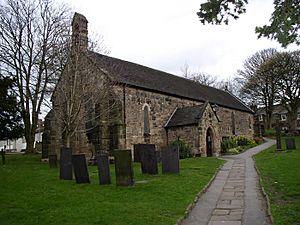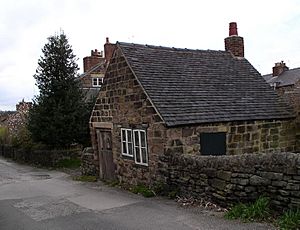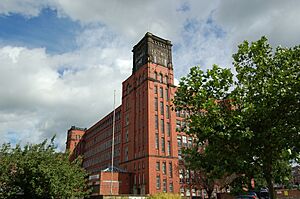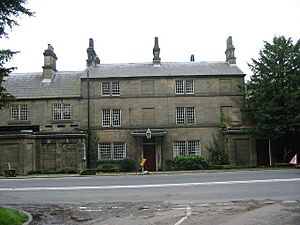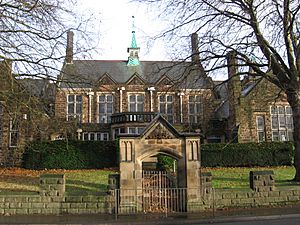Belper facts for kids
Quick facts for kids Belper |
|
|---|---|
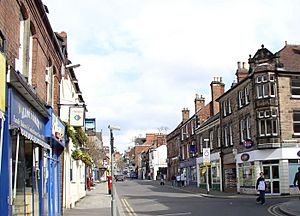 King Street |
|
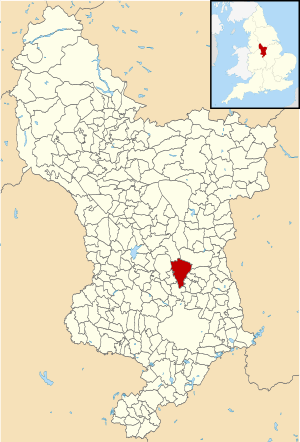 Belper parish highlighted within Derbyshire |
|
| Population | 21,822 (civil parish, 2011) |
| OS grid reference | SK351476 |
| Civil parish |
|
| District |
|
| Shire county | |
| Region | |
| Country | England |
| Sovereign state | United Kingdom |
| Post town | BELPER |
| Postcode district | DE56 |
| Dialling code | 01773 |
| Police | Derbyshire |
| Fire | Derbyshire |
| Ambulance | East Midlands |
| EU Parliament | East Midlands |
| UK Parliament |
|
Belper (/ˈbɛlpər/) is a town and civil parish in Derbyshire, England. It is located about 7 miles (11 km) north of Derby on the River Derwent. The parish includes the village of Milford and the small areas of Bargate, Blackbrook, and Makeney.
In 2011, the parish had a population of 21,823 people. Belper was known for making nails since the Middle Ages. It grew a lot during the early Industrial Revolution and became one of the first mill towns. This happened when many textile mills were built there. Because of its important history, Belper is now part of the Derwent Valley Mills World Heritage Site.
Contents
Belper's History
When the Normans took over England, Belper was part of the land around Duffield. This land belonged to the de Ferrers family. The Domesday Book of 1086 mentions a manor called "Bradley" in Belper. This area is now known as the Coppice.
The town's name, Belper, probably comes from Beaurepaire. This means "beautiful retreat" and was the name of a hunting lodge. The first mention of this lodge was in 1231. A chapel built around that time is still standing today. It was first called the Chapel of St Thomas in 1250. Later, during the time of King Henry VIII, it was renamed St John's Chapel. It is thought to be the oldest building in Belper. Today, it is used for town council meetings instead of church services.
Derbyshire has lots of coal and ironstone underground. People first dug these up from the surface. Later, they used shallow mines. This was important for the de Ferrers family, who worked with iron in Normandy. By the time of Henry VIII, Belper had grown quite a bit.
For a long time, starting in the 1200s, there were iron forges in Belper and Duffield. Making iron became a big way for people to earn money. Especially popular was making nails. By the late 1700s, there were about 500 workshops in Belper. These workshops made nails for the new textile mills. Machines took over nail-making in the 1800s. Some of the old nail-makers' houses are still around today. You can see them on local tours of the town.
The industrialist Jedediah Strutt built a cotton mill in Belper in the late 1700s. This mill used water power. It was only the second one like it in the world at that time. As the textile industry grew, Belper became one of the first mill towns. In 1784, Strutt built the North Mill and the West Mill. In 1803, the North Mill burned down. A new, fireproof building replaced it. More parts were added later, including the East Mill in 1913. The East Mill is a famous building in Belper today. Even though it no longer makes textiles, it still uses the river to make electricity. It uses special machines called turbines.
Jedediah Strutt had also invented a special way to make ribbed stockings. The easy supply of cotton helped the business of framework knitting. This type of knitting had been done in Belper and nearby villages since the mid-1700s. Machines arrived around 1850. But by then, men stopped wearing stockings as much. However, fancy patterned stockings for ladies became popular. So, the "cheveners" (people who made patterns) in Belper were very busy.
The building of the North Midland Railway in 1840 brought even more success to Belper. Belper was the first place in the UK to have gas lighting. The Strutts built a gas works in Milford. So many people wanted gas that in 1850, the Belper Gas and Coke Company was started. Electricity came later, in 1922. The first telephones arrived in 1895. Cars also appeared at the end of the century.
Belper continued to be a center for textiles and hosiery (stockings) into the 1900s. Other companies also started up. Park Foundry became a leader in heating systems. Adshead and Ratcliffe made a special putty for windows. Dalton and Company made lubricating oils and found ways to reuse old engine oil. This was very helpful during the Second World War. In 1938, A. B. Williamson created a product for silk stockings. When nylon stockings came out after the war, it seemed useless. But mechanics found it was great for cleaning hands. It is still sold today as Swarfega.
Belper's Location
Belper is about 8 miles (13 km) north of Derby. It is located in the valley of the River Derwent. In 2001, the town had 20,548 people living in 8,790 homes.
The civil parish of Belper also includes these communities and small areas:
- Bargate
- Belper Lane End
- Blackbrook
- Broadholm
- Far Laund
- Farnah Green
- Makeney
- Milford
- Mount Pleasant
- Openwoodgate
- White Moor
- Wyver
Blackbrook Hamlet
The small area of Blackbrook is about 2 miles (3 km) west of Belper. It is on the A517 Ashbourne road.
Openwoodgate Community
Openwoodgate is a nearby community to the east. It is about 1 mile from the center of Belper.
Wyver District
Wyver is a countryside area west of the River Derwent. It is just north of Belper and Mount Pleasant. It has a nature reserve on a 19-acre site. This reserve is on a flood plain, which means it often floods. This makes it a great place for wildlife, especially wading birds.
Local Hills
Hillside is west of Belper Lane End. It has the highest point in the parish, at 214 metres (702 ft).
Firestone Hill is west of the town, near the parish border. It is 191 metres (627 ft) high. Several communication masts are located there.
Another local hill is Bessalone Hill, at 182 metres (597 ft) to the north. It also has radio masts.
Pinchom's Hill is north of Bargate. It is 169 metres (554 ft) high.
Belper's Economy
Belper's economy used to rely on making things in factories. Many different goods were made in the town. Cotton spinning and making textiles were big jobs for most of the 1800s and early 1900s. The large East Mill and the smaller North Mill are the only parts of this industry left. They are now protected as part of the Derwent Valley Mills World Heritage Site.
During the Second World War, Rolls-Royce had its design team for the Merlin airplane engine in Belper. They also developed the Meteor tank engine here. After the war, J. W. Thornton, a chocolate maker, moved to Belper from Sheffield. This helped create jobs when the older industries were shrinking. In 1985, the company moved to a new place in Swanwick.
Today, most jobs in Belper are in shops and services. But some manufacturing still happens. The main shopping area is on King Street and Bridge Street. The town has three big supermarkets: Co-operative, Morrisons, and Aldi. There are also two discount shops, Poundland and B&M Bargains. Smaller Tesco and Co-op supermarkets are on the Whitemoor estate.
Getting Around Belper
Roads
The A6 is the main road that goes through the town. It runs next to the River Derwent on the west side.
Trains
Belper railway station is on the Midland Main Line. Regular trains between Derby and Matlock on the Derwent Valley Line usually stop here. Sometimes, a main line train to and from Sheffield also stops. This helps people from Belper who work in Sheffield. A group called 'Friends of the Derwent Valley Line' wants more of these services.
Buses
Belper has regular bus services to Derby and nearby towns and villages. There are also longer routes to Manchester and London. The main bus company is Trent Barton. Their bus garage is on Bridge Street.
Places of Worship
The oldest church still used for its original purpose is the Belper Unitarian Church. It was built in 1788. The current Methodist church opened on June 28, 1807. It was first built to hold 1,400 people.
St Peter's Church is a well-known building in the town. It was built in 1824. It replaced the smaller 13th-century St John's Chapel. St John's Chapel is now used by the town council. A second Anglican church, Christ Church, was built in 1850. Belper's churches work together in a group called "Churches Together."
The town also has Belper Baptist Church, a spiritualist church, a Roman Catholic church, Belper Congregational Church, and another Methodist church at Openwoodgate. There is also Belper Community Church.
Public Services
Babington Hospital provides health services for local people.
The town has a fire station. It has one fire engine with firefighters who are on call.
Belper's Culture
Sports Teams
Belper Town F.C. plays its home games at Christchurch Meadow. They are nicknamed the Nailers. This name comes from the town's history of making nails.
Belper Rugby Club plays its home games at Strutt's Playing Field. The club started in 1975.
Belper United F.C. is another football club in Belper.
Belper Meadows Cricket Club started in 1880. They still play at Christchurch Meadows.
Poetry Trail
In 2009, two poetry groups in Belper created a poetry trail. It was made to remember a local poet named Beth Fender, who passed away in 2002. Beth's Poetry Trail has 20 poems in different places around town. You can find them outside Belper Library, for example. The trail includes poems by famous writers like Emily Dickinson and Spike Milligan, as well as Beth's own poems.
Town Awards
In 2014, Belper won the High Street of the Year award for market towns. It also won the overall award! The judges said Belper has a "wonderful history" as a World Heritage Site. They also said it is a "thriving market town." The judges felt that Belper showed how a successful town can become a great place for everyone to visit. Belper won against towns like Brighton and Colwyn Bay. Belper won another award in 2019 for being a Champion High Street.
Music Scene
Belper Singers is a choir of about 25 voices. They sing different types of music. They perform about five times a year, sometimes even in cathedrals.
Belper also has a weekly folk club. It welcomes singers, musicians, poets, and listeners. Two traditional dance teams are based in the town: Heage Windmillers and Makeney Morris.
Andy Sneap was born in Belper. He is a Grammy-winning music producer, songwriter, and guitarist for the heavy metal band Hell. He is very active in producing metal music. He has produced over 100 albums at his Backstage Recording studios near Belper.
The Belper Moo
The Belper Moo started in March 2020. This was during the nationwide lockdown because of the COVID-19 crisis. Jasper Ward, a Belper resident, started it. He advertised it on social media as a way to "fight lockdown stress, boredom, and loneliness." Every evening at 6:30 PM, people in Belper were encouraged to moo like a cow from their windows, doors, and gardens. They had to follow social distancing rules.
The idea quickly became popular in Belper and spread fast. Many people made their own devices to make their moos louder. These were called 'Moocraphones' and other funny names. After being featured on BBC radio and online, 'The Moo' got attention from all over the world. People uploaded their 'moos' to the internet. Many creative things came from it, like songs, crafts, and poems. By early May, thousands of residents had taken part in The Belper Moo for over 50 days. The Moo was brought back during the November 2020 lockdown.
Pride in Belper
Belper has an annual Pride event. It supports the LGBT community. It usually happens on the first Saturday in August. It started in 2019 and has grown into a big community event. It includes a parade, music, and art activities.
Belper Arts Trail
The annual Belper Arts Trail is an event led by artists. It helps artists show and promote their work. It began in 2014 when two artists wanted to make the local art community stronger. They also wanted to find creative ways for artists to show their work since Belper didn't have many special places for it. During the Arts Trail weekend, art can be found in many unusual places.
Belper and Derbyshire have a lot of artistic talent. People felt Belper needed an interactive art trail. It has grown every year and is now a key event in Derbyshire. The trail happens every year on the May Day Bank Holiday.
Town Festivals
Belper is known for its festivals. These include "Belper Goes Green," which is a music event. It aims to teach people about environmental problems and how to reduce our impact on the planet. "Belper Games" is a festival where people compete in different challenges. "Belper Food Festival" has stalls with food and dishes from local businesses. "Belper Music Festival" features local musicians and bands playing in businesses. These events happen every year. They help the local economy and support small businesses in the town.
Media in Belper
Local news and TV shows come from BBC East Midlands and ITV Central. TV signals are received from the local TV transmitter.
Local radio stations include BBC Radio Derby (104.5 FM), Smooth East Midlands (101.4 FM), Capital East Midlands (102.8 FM), Greatest Hits Radio Midlands (106 FM), and Amber Sound FM. Amber Sound FM is a community station that broadcasts on 107.2 FM in the Amber Valley area and online.
Local newspapers are the Belper News and Derbyshire Times.
Schools in Belper
Primary Schools
There are eight primary schools that send students to the single secondary school:
- Holbrook Primary School
- St Elizabeth's Catholic Voluntary Academy
- St John's Church of England Primary School
- Herbert Strutt Primary School
- Pottery Primary School
- Long Row Primary School
- Ambergate Primary School
- Milford Primary School
Secondary Schools
Belper School and Sixth Form Centre has about 1,400 students aged 11–18. It was built in 1973 and was first called "Belper High School." It is next to Belper Leisure Centre. Famous people who went to this school include Ross Davenport, who won two swimming gold medals at the 2006 Commonwealth Games. Also, Alison Hargreaves, a famous mountain climber, went here.
Herbert Strutt Grammar School was one of the gifts from the Strutt family to the town. It became a middle school in 1973 when the new Belper High School opened. Later, it became a primary school. It was used until 2008, when a new building was built. Famous students from this school include actors Alan Bates and Timothy Dalton.
Belper's International Connections
Belper is twinned with Pawtucket, Rhode Island in the USA. This connection is because Samuel Slater, who learned from Jedediah Strutt, went to Pawtucket. There, he started the American cotton spinning industry.
Belper made international news in 2001. It rejected a gift of a large fibreglass Mr. Potato Head model from Pawtucket. Some people in Belper thought it was "hideous." The statue was fixed up and sent back in 2015. But people still have different opinions about it!
Famous People from Belper
- Tom Ballard, a rock climber and alpinist. He was the first climber to climb the six major alpine north faces alone in one winter.
- Alan Bates, an actor, went to Strutt's School.
- Maxwell Caulfield, a stage, film, and TV actor.
- Timothy Dalton, an actor who played James Bond, grew up here.
- Ross Davenport, a swimmer who won two gold medals at the Commonwealth Games.
- Monica Edwards, a children's writer, was born here in 1912.
- Alison Hargreaves, a mountain climber known for climbing Mount Everest without help. She grew up in Belper and went to Belper High School.
- Will Hay, a comedian and actor, lived in Belper in the 1920s.
- Andrew Jarrett, the tournament referee at Wimbledon for 14 years.
- Suzy Kendall, an actress in British and Italian films.
- John Lawton, a novelist, was born here.
- Penelope Mortimer, a novelist.
- Tracy Shaw, an actress who played Maxine Peacock in Coronation Street.
- Samuel Slater, known as the "father of the "American Industrial Revolution." He grew up on Chevin Road.
- Admiral Sir Trevor Alan Soar, a former leader of the Royal Navy, was born in Belper.
- Bombardier Charles Stone, who won the VC, was born and is buried here.
- Jedediah Strutt, an inventor and industrialist, opened his first mill in Belper in 1777.
- Frank Swettenham, a colonial ruler, was born in Belper in 1850.
- Nigel Vardy, a mountaineer, grew up in Belper.
- Ron Webster, a professional footballer, born in Belper in 1943. He played many games for Derby County.
See also
In Spanish: Belper para niños


